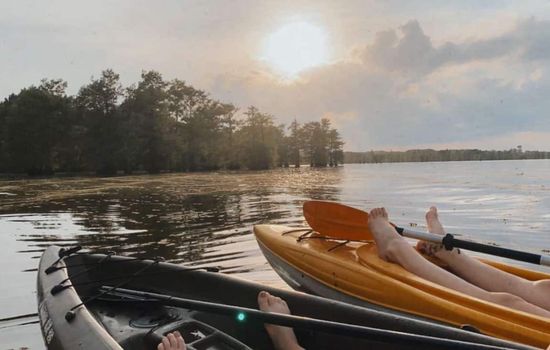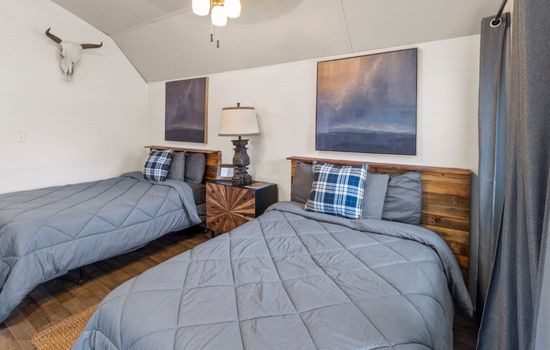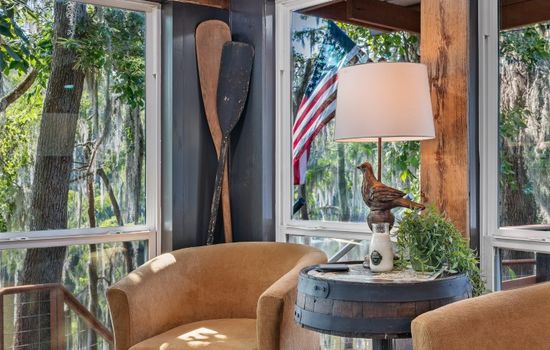The visitor center at Dr. Lester Sitzes III Bois D’Arc Wildlife Management Area in Missouri provides information on local wildlife and recreational activities. It is open from 8 AM to 4 PM, Monday through Friday, and closed on weekends and holidays.
There are no entrance fees for visitors. Parking is also free, making it accessible for outdoor activities.
From Kansas City, take I-70 E and then merge onto US-65 S towards Springfield. Continue on US-65 S for approximately 90 miles, then follow signs for the wildlife area, where nature’s tranquility awaits.
Dr. Lester Sitzes III Bois D’Arc Wildlife Management Area offers designated RV parking, motorcycle parking, accessible parking spaces, and bike racks for cyclists, ensuring convenient access for all visitors.
Accessibility & permits
Emergency
- Cell service availability:Full
Information not accurate?
Help us improve by making a suggestion.
Dr. Lester Sitzes III Bois D’Arc Wildlife Management Area in Missouri offers an exquisite retreat for nature enthusiasts and wildlife aficionados alike. Spanning over 1,000 acres, this pristine area showcases the diverse ecosystems of the Ozarks, providing a stunning backdrop for outdoor adventures. Visitors can immerse themselves in the beauty of rolling hills, lush woodlands, and serene wetlands, all while experiencing the rich tapestry of flora and fauna that call this region home.
Birdwatchers will find themselves captivated by the vibrant avian population, including migratory species that grace the skies during the changing seasons. The area is also a haven for deer and other wildlife, creating unparalleled opportunities for photography and observation. Hiking trails wind through the landscape, inviting explorers to discover hidden gems and breathtaking vistas at every turn.
Whether you seek solitude or adventure, Dr. Lester Sitzes III Bois D’Arc Wildlife Management Area promises a rejuvenating escape from the everyday. Embrace the tranquility of nature and create lasting memories in this remarkable corner of Missouri.
Top 3 Facts about Dr. Lester Sitzes III Bois D'Arc Wildlife Management Area
In this unique wildlife area, rare species like the endangered black-capped vireo can be spotted during migration, alongside unusual animal sightings such as the vibrant painted bunting, making it a hidden gem for birdwatchers and nature enthusiasts seeking extraordinary biodiversity experiences.
In this region, extreme temperature fluctuations can occur, with recorded highs reaching over 100°F in summer and lows plummeting below freezing in winter, creating unique microclimates that support diverse wildlife and unusual storm-related phenomena, such as sudden hailstorms and localized flooding events.
This area boasts unique trail names like “Coyote Howl” and unusual rules such as banning the use of drones, while also being known for hosting the state’s first youth archery tournament, attracting outdoor enthusiasts eager to explore its diverse recreational opportunities.
Family programs
- Junior Ranger
- Ranger-led Tours
- Self-guided Tours
- Workshops & Hands-on Activities
- Living History & Cultural Demos
- Scavenger Hunts
- Night Sky & Astronomy
- Family Camping & Overnight
- Volunteer & Stewardship
- Youth Conservation
- Scouting Partnerships
- Virtual Junior Activities
- Arts & Crafts
- Water-based Adventures
Travel Tips
Plan Ahead
To make the most of your visit, plan your trip around the seasonal wildlife patterns and weather conditions. Arrive early to secure prime viewing spots and pack essentials like binoculars, water, and snacks. Familiarize yourself with the area’s trails and regulations to enhance your experience and ensure a safe adventure among the stunning natural beauty.
Pack Appropriately
When packing for your trip, consider including a lightweight, waterproof poncho. The region’s unpredictable weather can shift from sunny to rainy in moments, especially during spring and fall. A poncho not only keeps you dry but also doubles as a makeshift shelter for unexpected downpours, ensuring you stay comfortable while exploring the diverse landscapes and wildlife.
Respect Wildlife
Respect wildlife by observing animals from a distance and avoiding any direct interaction. Stay on marked trails to protect their habitats and minimize disturbances. Bring binoculars to enhance your viewing experience without intruding on their space, and remember to leave no trace behind, ensuring that this natural haven remains pristine for generations to come.
Stay Informed
Before your visit, stay informed by checking the weather, temperatures, and any fire bans or notices. Know the emergency contact information and always tell someone your plans, including where you’re going and when you expect to return. Being prepared ensures a safe and enjoyable experience.
Seasons
In spring, the area bursts into vibrant life, offering unparalleled bird-watching and fishing opportunities amidst its lush landscapes and abundant wildlife.
Summer at Bois D’Arc Wildlife Management Area offers warm temperatures and abundant sunshine, ideal for fishing, bird-watching, and exploring its diverse wildlife.
In fall, the area transforms into a haven for birdwatchers and hunters alike, with migratory birds arriving and hunting seasons commencing, offering unparalleled wildlife experiences.
Experience the serene beauty of Missouri’s Bois D’Arc Conservation Area during winter, where crisp air and tranquil landscapes offer unparalleled opportunities for birdwatching and wildlife observation.
Information not accurate?
Help us improve by making a suggestion.
Where to stay
Frequently Asked Questions
Ready to dive into what Dr. Lester Sitzes III Bois D'Arc Wildlife Management Area has to offer? Let’s tackle some of the burning questions you might have as you plan your visit!
-
The hunting seasons at Dr. Lester Sitzes III Bois D’Arc Wildlife Management Area typically include various game species, with deer hunting occurring in the fall and spring turkey seasons. Waterfowl hunting is particularly popular during the designated migratory bird seasons, which generally run from late October through January, depending on specific regulations.
-
Camping is permitted at Dr. Lester Sitzes III Bois D’Arc Wildlife Management Area, offering a great opportunity for outdoor enthusiasts. There are designated camping areas available, but facilities may be limited, so visitors should plan accordingly and follow all regulations regarding campfires and waste disposal.
-
Wildlife at Dr. Lester Sitzes III Bois D’Arc Wildlife Management Area includes a diverse range of species. Visitors can expect to see white-tailed deer, wild turkeys, various waterfowl, and numerous bird species throughout the year. The area is also home to small mammals and reptiles, making it a vibrant ecosystem for wildlife observation.
-
Fishing opportunities are available at Dr. Lester Sitzes III Bois D’Arc Wildlife Management Area, with several ponds and waterways present. Anglers can catch species such as bass, catfish, and panfish. Visitors should check local regulations and fishing seasons before planning their trips.
-
Access restrictions during waterfowl season at Dr. Lester Sitzes III Bois D’Arc Wildlife Management Area may include designated hunting zones and specific times when access is limited to ensure a safe and successful hunting experience. It’s important for visitors to familiarize themselves with these restrictions to avoid any violations.







